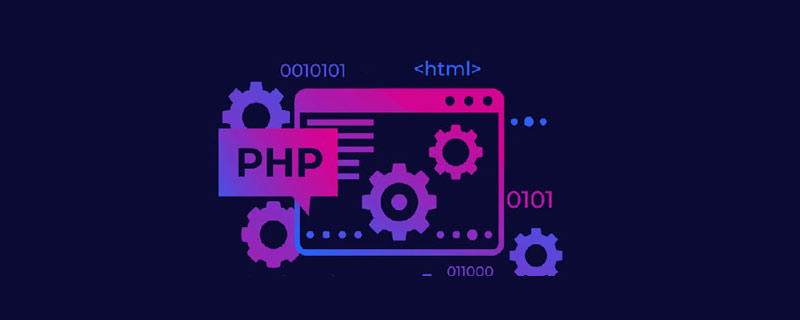本篇文章给大家带来了关于php的相关知识,其中主要跟大家聊一聊PHP适配器模式,还有代码示例,感兴趣的朋友下面一起来看一下吧,希望对大家有帮助。

PHP 适配器模式讲解和代码示例
适配器是一种结构型设计模式, 它能使不兼容的对象能够相互合作。
适配器可担任两个对象间的封装器, 它会接收对于一个对象的调用, 并将其转换为另一个对象可识别的格式和接口。
复杂度:******
流行度:******
使用示例: 适配器模式在 PHP 代码中很常见。 基于一些遗留代码的系统常常会使用该模式。 在这种情况下, 适配器让遗留代码与现代的类得以相互合作。
识别方法: 适配器可以通过以不同抽象或接口类型实例为参数的构造函数来识别。 当适配器的任何方法被调用时, 它会将参数转换为合适的格式, 然后将调用定向到其封装对象中的一个或多个方法。
真实世界示例
适配器允许你使用第三方或遗留系统的类, 即使它们与你的代码不兼容。 例如, 你可以创建一系列特殊的封装器, 来让应用所发出的调用与第三方类所要求的接口与格式适配, 而无需重写应用的通知接口以使其支持每一个第三方服务 (如钉钉、 微信、 短信或其他任何服务)。
index.php: 真实世界示例
<?php
namespace RefactoringGuru\Adapter\RealWorld;
/**
* The Target interface represents the interface that your application's classes
* already follow.
*/
interface Notification
{
public function send(string $title, string $message);
}
/**
* Here's an example of the existing class that follows the Target interface.
*
* The truth is that many real apps may not have this interface clearly defined.
* If you're in that boat, your best bet would be to extend the Adapter from one
* of your application's existing classes. If that's awkward (for instance,
* SlackNotification doesn't feel like a subclass of EmailNotification), then
* extracting an interface should be your first step.
*/
class EmailNotification implements Notification
{
private $adminEmail;
public function __construct(string $adminEmail)
{
$this->adminEmail = $adminEmail;
}
public function send(string $title, string $message): void
{
mail($this->adminEmail, $title, $message);
echo "Sent email with title '$title' to '{$this->adminEmail}' that says '$message'.";
}
}
/**
* The Adaptee is some useful class, incompatible with the Target interface. You
* can't just go in and change the code of the class to follow the Target
* interface, since the code might be provided by a 3rd-party library.
*/
class SlackApi
{
private $login;
private $apiKey;
public function __construct(string $login, string $apiKey)
{
$this->login = $login;
$this->apiKey = $apiKey;
}
public function logIn(): void
{
// Send authentication request to Slack web service.
echo "Logged in to a slack account '{$this->login}'.\n";
}
public function sendMessage(string $chatId, string $message): void
{
// Send message post request to Slack web service.
echo "Posted following message into the '$chatId' chat: '$message'.\n";
}
}
/**
* The Adapter is a class that links the Target interface and the Adaptee class.
* In this case, it allows the application to send notifications using Slack
* API.
*/
class SlackNotification implements Notification
{
private $slack;
private $chatId;
public function __construct(SlackApi $slack, string $chatId)
{
$this->slack = $slack;
$this->chatId = $chatId;
}
/**
* An Adapter is not only capable of adapting interfaces, but it can also
* convert incoming data to the format required by the Adaptee.
*/
public function send(string $title, string $message): void
{
$slackMessage = "#" . $title . "# " . strip_tags($message);
$this->slack->logIn();
$this->slack->sendMessage($this->chatId, $slackMessage);
}
}
/**
* The client code can work with any class that follows the Target interface.
*/
function clientCode(Notification $notification)
{
// ...
echo $notification->send("Website is down!",
"<strong style='color:red;font-size: 50px;'>Alert!</strong> " .
"Our website is not responding. Call admins and bring it up!");
// ...
}
echo "Client code is designed correctly and works with email notifications:\n";
$notification = new EmailNotification("developers@example.com");
clientCode($notification);
echo "\n\n";
echo "The same client code can work with other classes via adapter:\n";
$slackApi = new SlackApi("example.com", "XXXXXXXX");
$notification = new SlackNotification($slackApi, "Example.com Developers");
clientCode($notification);Output.txt: 执行结果
Client code is designed correctly and works with email notifications: Sent email with title 'Website is down!' to 'developers@example.com' that says '<strong style='color:red;font-size: 50px;'>Alert!</strong> Our website is not responding. Call admins and bring it up!'. The same client code can work with other classes via adapter: Logged in to a slack account 'example.com'. Posted following message into the 'Example.com Developers' chat: '#Website is down!# Alert! Our website is not responding. Call admins and bring it up!'.
概念示例
本例说明了适配器设计模式的结构并重点回答了下面的问题:
- 它由哪些类组成?
- 这些类扮演了哪些角色?
- 模式中的各个元素会以何种方式相互关联?
了解该模式的结构后, 你可以更容易地理解下面基于真实世界的 PHP 应用案例。
index.php: 概念示例
<?php
namespace RefactoringGuru\Adapter\Conceptual;
/**
* The Target defines the domain-specific interface used by the client code.
*/
class Target
{
public function request(): string
{
return "Target: The default target's behavior.";
}
}
/**
* The Adaptee contains some useful behavior, but its interface is incompatible
* with the existing client code. The Adaptee needs some adaptation before the
* client code can use it.
*/
class Adaptee
{
public function specificRequest(): string
{
return ".eetpadA eht fo roivaheb laicepS";
}
}
/**
* The Adapter makes the Adaptee's interface compatible with the Target's
* interface.
*/
class Adapter extends Target
{
private $adaptee;
public function __construct(Adaptee $adaptee)
{
$this->adaptee = $adaptee;
}
public function request(): string
{
return "Adapter: (TRANSLATED) " . strrev($this->adaptee->specificRequest());
}
}
/**
* The client code supports all classes that follow the Target interface.
*/
function clientCode(Target $target)
{
echo $target->request();
}
echo "Client: I can work just fine with the Target objects:\n";
$target = new Target();
clientCode($target);
echo "\n\n";
$adaptee = new Adaptee();
echo "Client: The Adaptee class has a weird interface. See, I don't understand it:\n";
echo "Adaptee: " . $adaptee->specificRequest();
echo "\n\n";
echo "Client: But I can work with it via the Adapter:\n";
$adapter = new Adapter($adaptee);
clientCode($adapter);Output.txt: 执行结果
Client: I can work just fine with the Target objects: Target: The default target's behavior. Client: The Adaptee class has a weird interface. See, I don't understand it: Adaptee: .eetpadA eht fo roivaheb laicepS Client: But I can work with it via the Adapter: Adapter: (TRANSLATED) Special behavior of the Adaptee.
推荐学习:《PHP视频教程》
以上是详述PHP适配器模式(附代码示例)的详细内容。更多信息请关注PHP中文网其他相关文章!
 PHP的当前状态:查看网络开发趋势Apr 13, 2025 am 12:20 AM
PHP的当前状态:查看网络开发趋势Apr 13, 2025 am 12:20 AMPHP在现代Web开发中仍然重要,尤其在内容管理和电子商务平台。1)PHP拥有丰富的生态系统和强大框架支持,如Laravel和Symfony。2)性能优化可通过OPcache和Nginx实现。3)PHP8.0引入JIT编译器,提升性能。4)云原生应用通过Docker和Kubernetes部署,提高灵活性和可扩展性。
 PHP与其他语言:比较Apr 13, 2025 am 12:19 AM
PHP与其他语言:比较Apr 13, 2025 am 12:19 AMPHP适合web开发,特别是在快速开发和处理动态内容方面表现出色,但不擅长数据科学和企业级应用。与Python相比,PHP在web开发中更具优势,但在数据科学领域不如Python;与Java相比,PHP在企业级应用中表现较差,但在web开发中更灵活;与JavaScript相比,PHP在后端开发中更简洁,但在前端开发中不如JavaScript。
 PHP与Python:核心功能Apr 13, 2025 am 12:16 AM
PHP与Python:核心功能Apr 13, 2025 am 12:16 AMPHP和Python各有优势,适合不同场景。1.PHP适用于web开发,提供内置web服务器和丰富函数库。2.Python适合数据科学和机器学习,语法简洁且有强大标准库。选择时应根据项目需求决定。
 PHP:网络开发的关键语言Apr 13, 2025 am 12:08 AM
PHP:网络开发的关键语言Apr 13, 2025 am 12:08 AMPHP是一种广泛应用于服务器端的脚本语言,特别适合web开发。1.PHP可以嵌入HTML,处理HTTP请求和响应,支持多种数据库。2.PHP用于生成动态网页内容,处理表单数据,访问数据库等,具有强大的社区支持和开源资源。3.PHP是解释型语言,执行过程包括词法分析、语法分析、编译和执行。4.PHP可以与MySQL结合用于用户注册系统等高级应用。5.调试PHP时,可使用error_reporting()和var_dump()等函数。6.优化PHP代码可通过缓存机制、优化数据库查询和使用内置函数。7
 PHP:许多网站的基础Apr 13, 2025 am 12:07 AM
PHP:许多网站的基础Apr 13, 2025 am 12:07 AMPHP成为许多网站首选技术栈的原因包括其易用性、强大社区支持和广泛应用。1)易于学习和使用,适合初学者。2)拥有庞大的开发者社区,资源丰富。3)广泛应用于WordPress、Drupal等平台。4)与Web服务器紧密集成,简化开发部署。
 超越炒作:评估当今PHP的角色Apr 12, 2025 am 12:17 AM
超越炒作:评估当今PHP的角色Apr 12, 2025 am 12:17 AMPHP在现代编程中仍然是一个强大且广泛使用的工具,尤其在web开发领域。1)PHP易用且与数据库集成无缝,是许多开发者的首选。2)它支持动态内容生成和面向对象编程,适合快速创建和维护网站。3)PHP的性能可以通过缓存和优化数据库查询来提升,其广泛的社区和丰富生态系统使其在当今技术栈中仍具重要地位。
 PHP中的弱参考是什么?什么时候有用?Apr 12, 2025 am 12:13 AM
PHP中的弱参考是什么?什么时候有用?Apr 12, 2025 am 12:13 AM在PHP中,弱引用是通过WeakReference类实现的,不会阻止垃圾回收器回收对象。弱引用适用于缓存系统和事件监听器等场景,需注意其不能保证对象存活,且垃圾回收可能延迟。
 解释PHP中的__ Invoke Magic方法。Apr 12, 2025 am 12:07 AM
解释PHP中的__ Invoke Magic方法。Apr 12, 2025 am 12:07 AM\_\_invoke方法允许对象像函数一样被调用。1.定义\_\_invoke方法使对象可被调用。2.使用$obj(...)语法时,PHP会执行\_\_invoke方法。3.适用于日志记录和计算器等场景,提高代码灵活性和可读性。


热AI工具

Undresser.AI Undress
人工智能驱动的应用程序,用于创建逼真的裸体照片

AI Clothes Remover
用于从照片中去除衣服的在线人工智能工具。

Undress AI Tool
免费脱衣服图片

Clothoff.io
AI脱衣机

AI Hentai Generator
免费生成ai无尽的。

热门文章

热工具

MinGW - 适用于 Windows 的极简 GNU
这个项目正在迁移到osdn.net/projects/mingw的过程中,你可以继续在那里关注我们。MinGW:GNU编译器集合(GCC)的本地Windows移植版本,可自由分发的导入库和用于构建本地Windows应用程序的头文件;包括对MSVC运行时的扩展,以支持C99功能。MinGW的所有软件都可以在64位Windows平台上运行。

螳螂BT
Mantis是一个易于部署的基于Web的缺陷跟踪工具,用于帮助产品缺陷跟踪。它需要PHP、MySQL和一个Web服务器。请查看我们的演示和托管服务。

安全考试浏览器
Safe Exam Browser是一个安全的浏览器环境,用于安全地进行在线考试。该软件将任何计算机变成一个安全的工作站。它控制对任何实用工具的访问,并防止学生使用未经授权的资源。

SublimeText3 Mac版
神级代码编辑软件(SublimeText3)

Dreamweaver Mac版
视觉化网页开发工具






